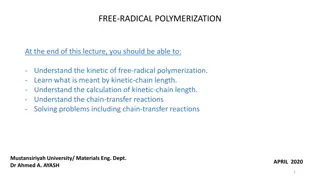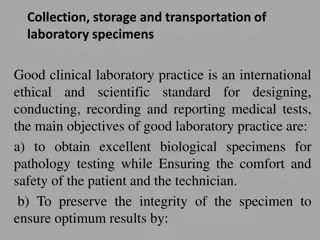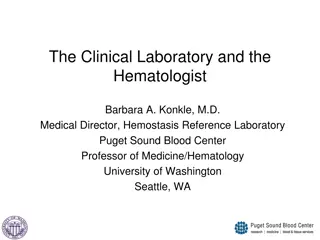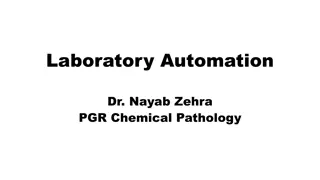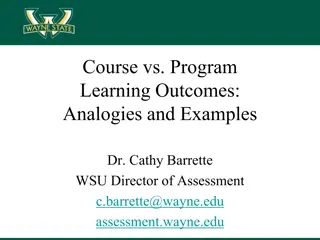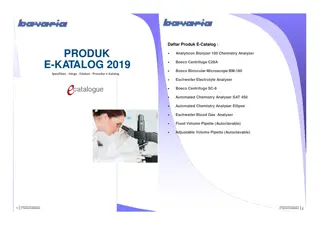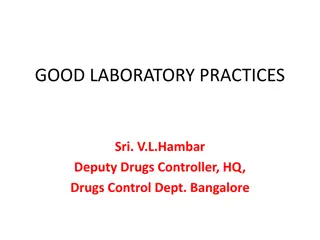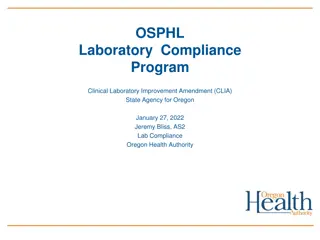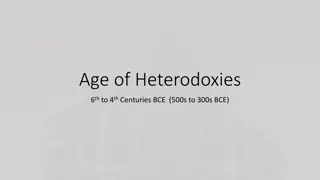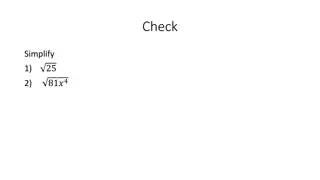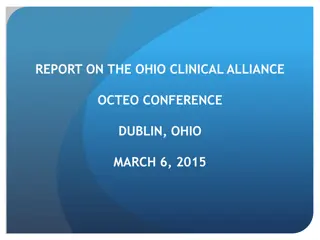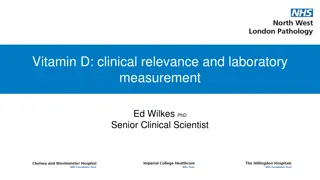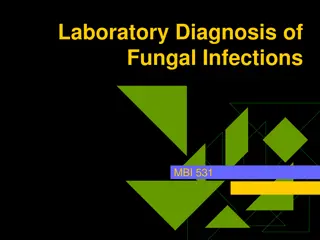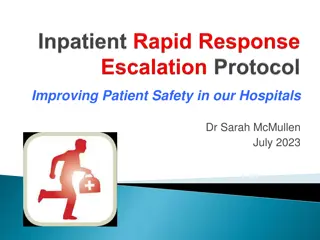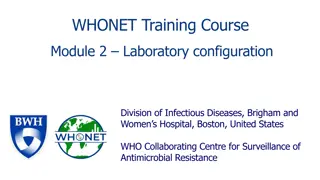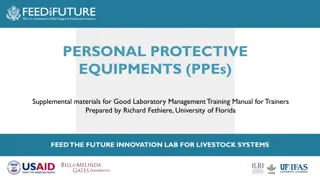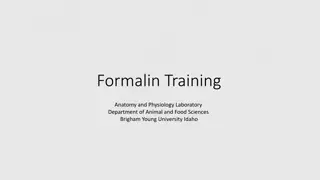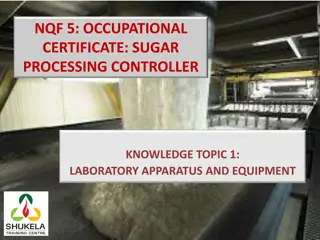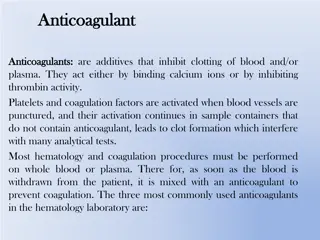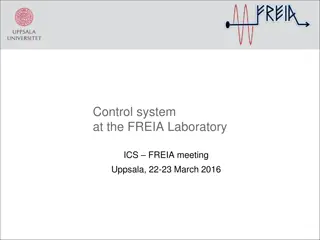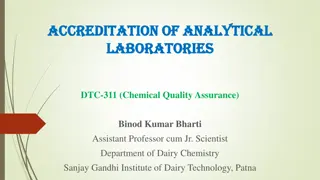Clinical and Laboratory Features of Radical Total Gastrectomy: Early Outcomes
Assessing the clinical and laboratory features, as well as the early outcomes following radical total gastrectomy is crucial in the management of gastric cancer. This study conducted at Hanoi Oncology Hospital retrospectively analyzed 43 patients who underwent this procedure. The overview includes diagnosis, history, complications, and surgical techniques associated with total gastrectomy. The research focuses on mortality rates, morbidity risks, lymph node involvement, and postoperative complications such as bleeding, anastomotic issues, and infections. Data analysis was performed using SPSS software. This comprehensive evaluation aims to contribute to the understanding and improvement of outcomes in gastric cancer treatment.
Download Presentation

Please find below an Image/Link to download the presentation.
The content on the website is provided AS IS for your information and personal use only. It may not be sold, licensed, or shared on other websites without obtaining consent from the author. Download presentation by click this link. If you encounter any issues during the download, it is possible that the publisher has removed the file from their server.
E N D
Presentation Transcript
ASSESS THE CLINICAL, LABORATORY FEATURES AND THE EARLY OUTCOMES AFTER RADICAL TOTAL GASTRECTOMY Thanh Le Van, MD. Hanoi Oncology Hospital.
Introduction Globocan 2012: 1.000.000 new cases of stomach cancer. The 5th most common malignancy in the world. Treatment: Surgery Chemotherapy, Radiationtherapy, Immunotherapy.
Introduction Total gastrectomy: The standard surgery of curative gastric cancer. Proper for proximal gastric cancer. Mortality and morbidity risks of this procedure are high. Viet nam: Rate of total gastrectomy is increasing. Outcomes re improving.
Overview Diagnosis of gastric cancer Signs and symptoms Laborator features History: upper abdominal pain, vomiting, nausea, flatulence Cachexia Anemia. Abdominal mass. Lymph node. Complications: Haematemesis Pyloric obstruction. Gastric perforation. Upper GI endoscopy. Biopsy. Endosopic ultrasonography Radiology: Barium study Abdomen utralsound, computer tomography. PET CT. Chest Xray Tumor marker: CEA, CA 19- 9, CA 72-4.
Overview History of total gastrectomy - 1881: Theodor Billroth performed the first successful gastrecstomy. - 1897: Geoger Schlatter performed the first total gastrecstomy (Zurich- Switzerland). - 1898: Charles Brooks Brigham (America).
Overview Lymph node
Overview Complications of total gastrectomy Bleeding. Esophagojejunal anastomosis: leakage, bleeding, stricture. Peritonitis, abscess. Acute pancreatitis. Other: Early bowel obstruction. Wound infection. Pneumonia. Deep veins thrombosis. Death.
Patients and method Restrospective study of 43 gastric cancer patients underwent radical total gastrectomy from January 2009 to August 2016 at Hanoi Oncology Hospital.
Patients and method Clinical presentations. Staging (AJCC 2010). Surgery. Mortality and morbidity.
Patients and method Statistical methods Data were analyzed using SPSS software (version 19.0; IBM, Inc., USA). The chi-square or Fisher exact tests were used for categorical and ordinal variables, and the independent-T test or one-way ANOVA were used for quantitative variables.
Age 34.9 30.2 35 30 25 16.3 16.3 20 15 10 2.3 5 0 41 - 50 51 - 60 61 - 70 > 70 40 Mean age: 59,7 9,9. Karimi (2014), Tr nhH ngS n (2001)...
Sex 20.9% 79.1% Male Female M/F: 3,8
CLINICAL FEATURES % n Epigastric pain 38 88,4 Hematemesis 6 14,0 Dysphagia 3 7,0 Vomiting 3 7,0 Anemia 10 23,3 Weight loss 20 46,5 Gastric outlet obstruction 7 16,3 Epigastric mass 1 2,3
Upper GI Endoscopy Tumor location 50% 41.9% 40% 30% 25.6% 20.9% 20% 11.6% 10% 0% Proximal Middle Distal Diffuse
Upper GI endoscopy Borrmann s classification 60% 51.2% 50% 40% 27.9% 30% 20% 11.6% 09.3% 10% 0% Polypoid Fungating Ulcerated Diffusely infiltrative -10%
Pathology Signet-ring cell 23.3% Mucinous adenocarcinoma 34.9% Adenocarcinoma well differentiated 14.0% Adenocarcinoma moderately differentiated 4.7% 23.3% Adenocarcinoma poorly differentiated
Stage Stage n % Tumor T1 T2 T3 T4 2 4 2 4,7 9,3 4,7 81,4 o nTr ng T (2011): T4: 54,1% D/c h ch: 57,4%. Nguy nC ngTh nh (2010): T4 g p 57,2%; D/c h ch: 60,4%. 35 Lymph node Kh ng C Metastatic 14 29 32,6 67,4 M0 M1 43 0 100,0 0,0 Stage I: 5,1%; Stage II: 29.8%; Stage III: 65,1%.
Surgery features Gastrectomy Total gastrectomy n 33 10 % 76,7 23,3 Extent surgery Lymph node dissection D1 7 16,3 D2 36 83,7 Reconstruction type Roux-en-Y 21 48,8 Omega 22 51,2
Mortality and morbidity 16.3% 83.7% Morbidity Mortality: 2,3%.
Mortality and morbidity Other Vietnam studies Place Morbidity 6% 14,5% 18,3% Mortality 0,9% 0 3,3% Phan Minh Ng c (2011) Nguy nV n Long (2011) o nTr ng T (2011) Nguy nTr ngH o (2013) H Y d c TP BV Vi t c BV Ch R y BV K 19% 0 HCM BV UB HN This study 16,3% 2,3%
Mortality and morbidity N % R mi ngn i TQ - ru t 2 4,6 Vi m ph c m c to n th 1 2,3 Vi m t yc p 3 7,0 Nhi m tr ng v tm 1 2,3 T cru ts m 2 4,6 Vi m ph i 2 4,6 T cm ch 1 2,3
No Risk factor p Comlication complication 17 19 29 7 < 60 60 Yes No 3 4 4 3 0,582 Age Extent surgery 0,192 D1 1 6 Lymph node dissection 0,682 D2 6 30 Roux-en-Y Omega Stage I Stage II 2 5 0 2 19 17 4 9 0,226 Anastomosis 0,651 Stage Stage III 5 23
1. Clinical features: Most of patient over 50 year olds, male/female: 3,8. The common symptoms include: Stomachache (88,4%), weigh loss (46,5%), anemia (23,3%). Tumor often located at two third upper of gastric. The common type is fungating (51,2%). Stage III (65,1%)
2. Outcomes: Surgery: 23,3% patients underwent extra total gastrectomy and most of patients received D2 L.N dissection. Roux en Y anastomosis equal Omega. Morbidity: 16,3%; mortality: 2,3%.





